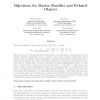202 search results - page 10 / 41 » Counting Distance Permutations |
PKC
2001
Springer
14 years 4 days ago
2001
Springer
Quite recently, in [4], a new time-memory tradeoff algorithm was presented. The original goal of this algorithm was to count the number of points on an elliptic curve, however, th...
COMBINATORICS
1998
13 years 7 months ago
1998
We show that the moments of the trace of a random unitary matrix have combinatorial interpretations in terms of longest increasing subsequences of permutations. To be precise, we s...
JCT
2011
13 years 2 months ago
2011
The Baxter number Bn can be written as Bn = n k=0 Θk,n−k−1 with Θk,ℓ = 2 (k + 1)2 (k + 2) k + ℓ k k + ℓ + 1 k k + ℓ + 2 k . These numbers have first appeared in the...
DM
2008
13 years 7 months ago
2008
We introduce random recursive trees, where deterministically weights are attached to the edges according to the labeling of the trees. We will give a bijection between recursive t...
IJSNET
2006
13 years 7 months ago
2006
: In this paper we focus on exploiting the information provided by a generally accepted and largely ignored hypothesis (the random deployment of the nodes of an ad hoc or wireless ...


